A Framework to Evaluate Urban Flood Resilience of Design Alternatives for Flood Defence Considering Future Adverse Scenarios
Abstract
1. Introduction
2. Material and Methods
2.1. Computational Modelling System
2.2. Urban Flood Resilience Index—UFRI
- (i)
- absorptive capacity—the ability of the system to absorb the disruptive event, represented by the Sub-index of Risk to Resistance Capacity ().
- (ii)
- adaptive capacity—the ability to adapt to the event, represented by the Sub-index of Risk to System Functional Capacity ().
- (iii)
- restorative capacity—the ability of the system to recover, represented by the Sub-index of Risk to Material Recovery Capacity ().
2.2.1. Sub-Index of Risk to Resistance Capacity ()
2.2.2. Sub-Index of Risk to Material Recovery Capacity ()
- : Cost of damage to a building
- : Cost of damage to building contents
- : Total area built in the analysis unit
- : Building susceptibility indicator
- : Total Income of the population in the analysed region
- : Average replacement capacity of the population in the analysed region
- : indicator of vulnerable persons
- : indicator of non-vulnerable persons
- : velocity factor indicator for vulnerable people
- : velocity factor indicator for non-vulnerable people
2.2.3. Sub-Index of Risk to System Functional Capacity ()
- : total duration of floods with water depths between 10 cm and 25 cm
- : total duration of floods with water depths between 25 cm and 50 cm
- : total duration of floods with water depths greater than 50 cm
2.3. A New Methodological Framework to Measure Urban Flood Resilience
2.4. Future Scenarios Criterion
2.5. Case Study: Canal Do Mangue Catchment
2.6. Simulation Scenarios
3. Results and Discussion
3.1. Application of the UFRI in the Present
3.2. Application of the Future Scenarios Criterion—FSC
- aFResI for Scenario C1—concentrated interventions:
- aFResI for Scenario C2—distributed interventions:
4. Conclusions
Author Contributions
Funding
Acknowledgments
Conflicts of Interest
Abbreviations
| aFResI | Adapted Flood Resilience Index |
| BMPs | Best Management Practices |
| CBA | Cost-Benefit Analysis |
| FResI | Flood Resilience Index |
| FRI | Flood Risk Index |
| FRM | Flood Risk Management |
| FSC | Future Scenarios Criterion |
| GI | Green Infrastructure |
| LID | Low Impact Development (LID) |
| MODCEL | Urban Flow Cell Model, in Portuguese, Modelo de Células de Escoamento |
| MSL | Mean Sea Level |
| RP | Return Period |
| RCP | Representative Concentration Pathway |
| SES | Social-ecological system |
| SuDS | Sustainable Urban Drainage Systems |
| UFRI | Urban Flood Resilience Risk |
| WSUD | Water Sensitive Urban Design |
References
- Sörensen, J.; Persson, A.; Sternudd, C.; Aspegren, H.; Nilsson, J.; Nordström, J.; Jönsson, K.; Mottaghi, M.; Becker, P.; Pilesjö, P.; et al. Re-Thinking Urban Flood Management—Time for a Regime Shift. Water 2016, 8, 332. [Google Scholar] [CrossRef]
- Driessen, P.; Hegger, D.; Kundzewicz, Z.; van Rijswick, H.; Crabbé, A.; Larrue, C.; Matczak, P.; Pettersson, M.; Priest, S.; Suykens, C.; et al. Governance Strategies for Improving Flood Resilience in the Face of Climate Change. Water 2018, 10, 1595. [Google Scholar] [CrossRef]
- Brown, R.R.; Keath, N.; Wong, T.H.F. Urban water management in cities: historical, current and future regimes. Water Sci. Technol. 2009, 59, 847–855. [Google Scholar] [CrossRef] [PubMed]
- Sayers, P.; Yuanyuan, L.; Galloway, G.; Penning-Rowsell, E.; Fuxin, S.; Kang, W.; Yiwei, C.; Le Quesne, T. Flood Risk Management: A Strategic Approach; UNESCO: Pairs, France, 2013; ISBN 9789230011598. [Google Scholar]
- Nascimento, N.O.; Ellis, J.B.; Baptista, M.B.; Deutsch, J.-C. Using detention basins: operational experience and lessons. Urban Water 1999, 1, 113–124. [Google Scholar] [CrossRef]
- UNISDR. Economic Losses, Poverty & Disasters—1998–2017; Centre for Research on the Epidemiology of Disasters & UN Office for Disaster Risk Reduction: Genebra, Switzerland, 2017. [Google Scholar]
- Zevenbergen, C.; Fu, D.; Pathirana, A. Transitioning to Sponge Cities: Challenges and Opportunities to Address Urban Water Problems in China. Water 2018, 10, 1230. [Google Scholar] [CrossRef]
- Fletcher, T.D.; Shuster, W.; Hunt, W.F.; Ashley, R.; Butler, D.; Arthur, S.; Trowsdale, S.; Barraud, S.; Semadeni-Davies, A.; Bertrand-Krajewski, J.L.; et al. SUDS, LID, BMPs, WSUD and more—The evolution and application of terminology surrounding urban drainage. Urban Water J. 2015, 12, 525–542. [Google Scholar] [CrossRef]
- Barría, P.; Cruzat, M.L.; Cienfuegos, R.; Gironás, J.; Eucariaza, C.; Bonilla, C.; Moris, R.; Ledezma, C.; Guerra, M.; Rodríguez, R.; et al. From Multi-Risk Evaluation to Resilience Planning: The Case of Central Chilean Coastal Cities. Water 2019, 1–24. [Google Scholar] [CrossRef]
- Kaykhosravi, S.; Khan, U.; Jadidi, A. A Comprehensive Review of Low Impact Development Models for Research, Conceptual, Preliminary and Detailed Design Applications. Water 2018, 10, 1541. [Google Scholar] [CrossRef]
- Sharma, A.K.; Pezzaniti, D.; Myers, B.; Cook, S.; Tjandraatmadja, G.; Chacko, P.; Chavoshi, S.; Kemp, D.; Leonard, R.; Koth, B.; et al. Water sensitive urban design: An investigation of current systems, implementation drivers, community perceptions and potential to supplement urban water services. Water 2016, 8, 272. [Google Scholar] [CrossRef]
- Holman-Dodds, J.K.; Bradley, A.A.; Potter, K.W. Evaluation of hydrologic benefits of infiltration based urban storm water management. J. Am. Water Resour. Assoc. 2003, 39, 205–215. [Google Scholar] [CrossRef]
- Dierkes, C.; Göbel, P.; Benze, W.; Wells, J. Next Generation Water Sensitive Stormwater Management Techniques. In Proceedings of the Second national conference on water sensitive urban design, Brisbane, Australia, 2–4 September 2000. [Google Scholar]
- Swan, A.; Stovin, V.R.; Saul, A.J.; Walker, N. Modelling SUDS with deterministic urban drainage models. In Proceedings of the 1st National Conference on Sustainability Drainage, Coventry University, Coventry, UK, 18–19 June 2001. [Google Scholar]
- Swan, A. How increased urbanisation has induced flooding problems in the UK: A lesson for African cities? Phys. Chem. Earth 2010, 35, 643–647. [Google Scholar] [CrossRef]
- Morita, M. Flood risk impact factor for comparatively evaluating the main causes that contribute to flood risk in urban drainage areas. Water 2014, 6, 253–270. [Google Scholar] [CrossRef]
- Gunderson, L.; Holling, C.S. Panarchy: Understanding Transformations in Human and Natural Systems; Gunderson, L., Holling, C.S., Eds.; Island Press: Washington, DC, USA, 2002; ISBN 1559638567. [Google Scholar]
- Cumming, G.S.; Barnes, G.; Perz, S.; Schmink, M.; Sieving, K.E.; Southworth, J.; Binford, M.; Holt, R.D.; Stickler, C.; Van Holt, T. An exploratory framework for the empirical measurement of resilience. Ecosystems 2005, 8, 975–987. [Google Scholar] [CrossRef]
- Goonetilleke, A.; Thomas, E.; Ginn, S.; Gilbert, D. Understanding the role of land use in urban stormwater quality management. J. Environ. Manage. 2005, 74, 31–42. [Google Scholar] [CrossRef] [PubMed]
- Spence, K.; Bridge, J.; Mcluckie, D.; Kandasamy, J. Urban Stormwater and Flood Management. In Urban Stormwater and Flood Management. Applied Environmental Science and Engineering for a Sustainable Future; Jegatheesan, V., Goonetilleke, A., van Leeuwen, J., Kandasamy, J., Warner, D., Myers, B., Bhuiyan, M., Spence, K., Parker, G., Eds.; Applied Environmental Science and Engineering for a Sustainable Future; Springer International Publishing: Cham, Switzerland, 2019; pp. 139–157. ISBN 978-3-030-11817-4. [Google Scholar]
- Koutsoyiannis, D. Advances in Urban Flood Management; CRC Press: Boca Raton, FL, USA, 2007; ISBN 9788578110796. [Google Scholar]
- Pottier, N.; Penning-Rowsell, E.; Tunstall, S.; Hubert, G. Land use and flood protection: Contrasting approaches and outcomes in France and in England and Wales. Appl. Geogr. 2005, 25, 1–27. [Google Scholar] [CrossRef]
- Miguez, M.G.; Veról, A.P.; Rêgo, A.Q.d.S.F.; Lourenço, I.B. Urban Agglomeration and Supporting Capacity: The Role of Open Spaces within Urban Drainage Systems as a Structuring Condition for Urban Growth. In Urban Agglomeration; InTech: Vienna, Austria, 2018; Volume 2, pp. 137–164. ISBN 9789537619992. [Google Scholar]
- Di Baldassarre, G.; Viglione, A.; Carr, G.; Kuil, L.; Salinas, J.L.; Blöschl, G. Socio-hydrology: Conceptualising human-flood interactions. Hydrol. Earth Syst. Sci. 2013, 17, 3295–3303. [Google Scholar] [CrossRef]
- De Bruijn, K.M. Resilience and flood risk management. Water Policy 2004, 6, 53–66. [Google Scholar] [CrossRef]
- Withanachchi, S.S.; Kunchulia, I.; Ghambashidze, G.; Al Sidawi, R.; Urushadze, T.; Ploeger, A. Farmers’ perception of water quality and risks in the Mashavera River Basin, Georgia: Analyzing the vulnerability of the social-ecological system through community perceptions. Sustainability 2018, 10, 3062. [Google Scholar] [CrossRef]
- Barendrecht, M.H.; Viglione, A.; Blöschl, G. A dynamic framework for flood risk. Water Secur. 2017, 1, 3–11. [Google Scholar] [CrossRef]
- Miguez, M.G.; Veról, A.P. A catchment scale Integrated Flood Resilience Index to support decision making in urban flood control design. Environ. Plan. B Urban Anal. City Sci. 2017, 44, 925–946. [Google Scholar] [CrossRef]
- Han, N.-X.; Xing, F.; Han, N.-X.; Xing, F. A Comprehensive Review of the Study and Development of Microcapsule Based Self-Resilience Systems for Concrete Structures at Shenzhen University. Materials 2016, 10, 2. [Google Scholar] [CrossRef] [PubMed]
- Beer, F.; Johnston, E.R.; Eisenberg, E. Vector Mechanics for Engineers: Statics and Dynamics; McGraw-Hill Education: New York, NY, USA, 2009; ISBN 978-0-07-352940-0. [Google Scholar]
- Janssen, M.A.; Bodin, Ö.; Anderies, J.M.; Elmqvist, T.; Ernstson, H.; McAllister, R.R.J.; Olsson, P.; Ryan, P. Toward a network perspective of the study of resilience in social-ecological systems. Ecol. Soc. 2006, 11, 15. [Google Scholar] [CrossRef]
- Holling, C.S. Engineering Resilience versus Ecological Resilience. Eng. Ecol. Constraints 1996, 31–34. Available online: http://www.environmentalmanager.org/wp-content/uploads/2008/03/holling-eng-vs-eco-resilience.pdf (accessed on 17 July 2019).
- Adger, W.N. Social and ecological resilience: are they related? Prog. Hum. Geogr. 2000, 24, 347–364. [Google Scholar] [CrossRef]
- Mak, W.W.S.; Ng, I.S.W.; Wong, C.C.Y. Resilience: Enhancing well-being through the positive cognitive triad. J. Couns. Psychol. 2011, 58, 610–617. [Google Scholar] [CrossRef] [PubMed]
- Rivera, F.I.; Kapucu, N. Geography and Resilience; Springer International Publishing: Cham, Switzerland, 2015; ISBN 978-3-319-16452-6. [Google Scholar]
- Folke, C. Resilience: The emergence of a perspective for social-ecological systems analyses. Glob. Environ. Chang. 2006, 16, 253–267. [Google Scholar] [CrossRef]
- Weichselgartner, J.; Kelman, I. Geographies of resilience. Prog. Hum. Geogr. 2014, 39, 249–267. [Google Scholar] [CrossRef]
- Meerow, S.; Newell, J.P.; Stults, M. Defining urban resilience: A review. Landsc. Urban Plan. 2016, 147, 38–49. [Google Scholar] [CrossRef]
- Keating, A.; Campbell, K.; Szoenyi, M.; Mcquistan, C.; Nash, D.; Burer, M. Development and testing of a community flood resilience measurement tool. Nat. Hazards Earth Syst. Sci. 2017, 17, 77–101. [Google Scholar] [CrossRef]
- Chen, K.F.; Leandro, J. A Conceptual Time-Varying Flood Resilience Index for Urban Areas: Munich City. Water 2019, 11, 830. [Google Scholar] [CrossRef]
- McBain, W.; Wilkes, D.; Retter, M. Flood Resilience for Critical Infrastructure and Services; CIRIA: London, UK, 2010; ISBN 978-0-86017-688-6. [Google Scholar]
- Kötter, T.; Vafeidis, A.; Moghadas, M.; Asadzadeh, A.; Fekete, A. A multi-criteria approach for assessing urban flood resilience in Tehran, Iran. Int. J. Disaster Risk Reduct. 2019, 35, 101069. [Google Scholar]
- Murdock, H.; de Bruijn, K.; Gersonius, B.; Murdock, H.J.; De Bruijn, K.M.; Gersonius, B. Assessment of Critical Infrastructure Resilience to Flooding Using a Response Curve Approach. Sustainability 2018, 10, 3470. [Google Scholar] [CrossRef]
- Cutter, S.L.; Barnes, L.; Berry, M.; Burton, C.; Evans, E.; Tate, E.; Webb, J. A place-based model for understanding community resilience to natural disasters. Glob. Environ. Chang. 2008, 18, 598–606. [Google Scholar] [CrossRef]
- Batica, J. Methodology for Flood Resilience Assessment in Urban Environments and Mitigation Strategy Development. Ph.D. Thesis, Université Nice Sophia, Antipolis, France, 2015. [Google Scholar]
- Baptista, S.R. Design and Use of Composite Indices in Assessment of Climate Change Vulnerability and Resilience; The Earth Institute, Columbia University: New York, NY, USA, 2014. [Google Scholar]
- Kotzee, I.; Reyers, B. Piloting a social-ecological index for measuring flood resilience: A composite index approach. Ecol. Indic. 2016, 60, 45–53. [Google Scholar] [CrossRef]
- Zhang, D.; Gersberg, R.M.; Ng, W.J.; Tan, S.K. Conventional and decentralized urban stormwater management: A comparison through case studies of Singapore and Berlin, Germany. Urban Water J. 2017, 14, 113–124. [Google Scholar] [CrossRef]
- Zonensein, J.; Gomes Miguez, M.; Cesar, F.; Mascarenhas, B. Flood Risk Index as an Urban Management Tool. In Proceedings of the 11th International Conference on Urban Drainage, Palermo, Italy, 23–26 September 2008. [Google Scholar]
- Rezende, O.M.; Miguez, M.G.; Franco, A.B.R.d.C.; Oliveira, A.K.B.; Miranda, F.M.; Jacob, A.C.P.; Sousa, M.M. Index of risk to material recovery capacity. In Proceedings of the 13th Sustainable Development of Energy, Water and Environment Systems (SDEWES); Faculty of Mechanical Engineering and Naval Architecture, Zagreb: Palermo, Italy, 2018; pp. 1–16. [Google Scholar]
- Rezende, O.M.; de Franco, A.B.R.; Oliveira, A.K.B.; Jacob, A.C.P.; Miguez, M.G. A Framework to Assess Urban Floods Resilience. In New Trends in Urban Drainage Modelling. UDM 2018; Mannina, G., Ed.; Springer: Cham, Switzerland, 2018; pp. 533–538. ISBN 978-3-319-99867-1. [Google Scholar]
- Bertilsson, L.; Wiklund, K.; de Moura Tebaldi, I.; Rezende, O.M.; Veról, A.P.; Miguez, M.G. Urban flood resilience—A multi-criteria index to integrate flood resilience into urban planning. J. Hydrol. 2019, 573, 970–982. [Google Scholar] [CrossRef]
- Mascarenhas, F.C.B.; Miguez, M.G. Urban flood control through a mathematical cell model. Water Int. 2002, 27, 208–218. [Google Scholar] [CrossRef]
- Miguez, M.G.; Battemarco, B.P.; De Sousa, M.M.; Rezende, O.M.; Veról, A.P.; Gusmaroli, G. Urban flood simulation using MODCEL-an alternative quasi-2D conceptual model. Water 2017, 9, 445. [Google Scholar] [CrossRef]
- Zanobetti, D.; Lorgeré, H. Le modèle mathématique du Delta du Mékong. La Houille Blanche 1968, 17–30. [Google Scholar] [CrossRef]
- Miguez, M.G.; Radesca, F.D.; Veról, A.P.; de Sousa, M.M.; Oliveira, L.F.G.S. Multilayer Modelling as a Supporting Tool for Flood Diagnosis and Drainage System Design. In New Trends in Urban Drainage Modelling. UDM 2018; Mannina, G., Ed.; Springer: Cham, Switzerland, 2019; pp. 490–495. ISBN 978-3-319-99867-1. [Google Scholar]
- Proag, V. The Concept of Vulnerability and Resilience. Procedia Econ. Financ. 2014, 18, 369–376. [Google Scholar] [CrossRef]
- Salgado, J.C.M. Economic Assessment of Drainage and Flood Control Projects in Urban Basins. Ph.D. Thesis, Universidade Federal do Rio de Janeiro, Rio de Janeiro, RJ, Brazil, 1995. [Google Scholar]
- Escudero-Bueno, I.; Torres, A.M.; Rodríguez, J.T.C.; Momparler, S.P. SUFRI Methodology for Pluvial and River Flooding Risk Assessment in Urban Areas to Inform Decision-Making; WP3 Final Report, ERA-NET CRUE, SUFRI project—Sustainable Strategies of Urban Flood Risk Management with non-structural measures to cope with the residual risk, 2nd ERA-Net CRUE Funding Initiative; Graz University of Technology: Styria, Austria, 2011. [Google Scholar]
- RESCDAM. The Use of Physical Models in Dam-Break Flood Analysis; Final Report; Helsinki University of Technology: Helsinki, Finland, 2000. [Google Scholar]
- McBain, W.; Wilkes, D.; Retter, M. Flood Resilience and Resistance for Critical Infrastructure; Ciria, Classic House: London, UK, 2010. [Google Scholar]
- Zanetti, V.; De Sousa Junior, W.; De Freitas, D. A Climate Change Vulnerability Index and Case Study in a Brazilian Coastal City. Sustainability 2016, 8, 811. [Google Scholar] [CrossRef]
- Marengo, J.A. Mudanças Climáticas Globais e seus Efeitos Sobre a Biodiversidade: Caracterização do Clima Atual e Definição das Alterações Climáticas para o Território Brasileiro ao Longo do século XXI, 2nd ed.; MMA: Brasilia, Brazil, 2017; Volume 1, ISBN 85-7738-038-6. [Google Scholar]
- Collins, M.; Knutti, R.; Arblaster, J.; Dufresne, J.-L.; Fichefet, T. Long-term Climate Change: Projections, Commitments and Irreversibility. In Climate Change 2013: The Physical Science Basis. Contribution of Working Group I to the Fifth Assessment Report of the Intergovernmental Panel on Climate Change; Stocker, T.F., Qin, D., Plattner, G.-K., Tignor, M., Allen, S.K., Boschung, J., Nauels, A., Xia, Y., Bex, V., Midgley, P.M., Eds.; Cambridge University Press: Cambridge, UK, 2013; p. 107. [Google Scholar]
- Stocker, T.F.; Dahe, Q.; Plattner, G.-K.; Alexander, L.V.; Allen, S.K.; Bindoff, N.L.; Bréon, F.-M.; Church, J.A.; Cubash, U.; Emori, S.; et al. IPCC Technical Summary AR5. Available online: https://www.ipcc.ch/site/assets/uploads/2018/02/WG1AR5_TS_FINAL.pdf (accessed on 17 July 2019).
- Marengo, J.A.; Scarano, F.R.; Klein, A.F.; Souza, C.R.G.; Chou, S.C. Impacto, vulnerabilidade e adaptação das cidades costeiras brasileiras às mudanças climáticas; Marengo, J.A., Scarano, F.R., Eds.; PBMC, COPPE-UFRJ: Rio de Janeiro, Brazil, 2016; ISBN 9788528503456. [Google Scholar]
- Santos, R.T.F. Efeitos da subida do nível do mar na inundação costeira na costa leste do Brasil devido às mudanças climáticas. Ph.D. Thesis, Federal University of Rio de Janeiro, Rio de Janeiro, Brazil, 2017. [Google Scholar]
- Baptista, M.; Nascimento, N.; Barraud, S. Técnicas Compensatórias em Drenagem Urbana, 1st ed.; ABRH: Porto Alegre, Brazil, 2011; ISBN 9788588686311. [Google Scholar]
- Hoang, L.; Fenner, R.A. System interactions of stormwater management using sustainable urban drainage systems and green infrastructure. Urban Water J. 2016, 13, 739–758. [Google Scholar] [CrossRef]
- Manual for Proposals for Sustainable urban Drainage Systems and Stormwater Management (in Portuguese); Ministério das Cidades: Brasília, Brazil, 2012.
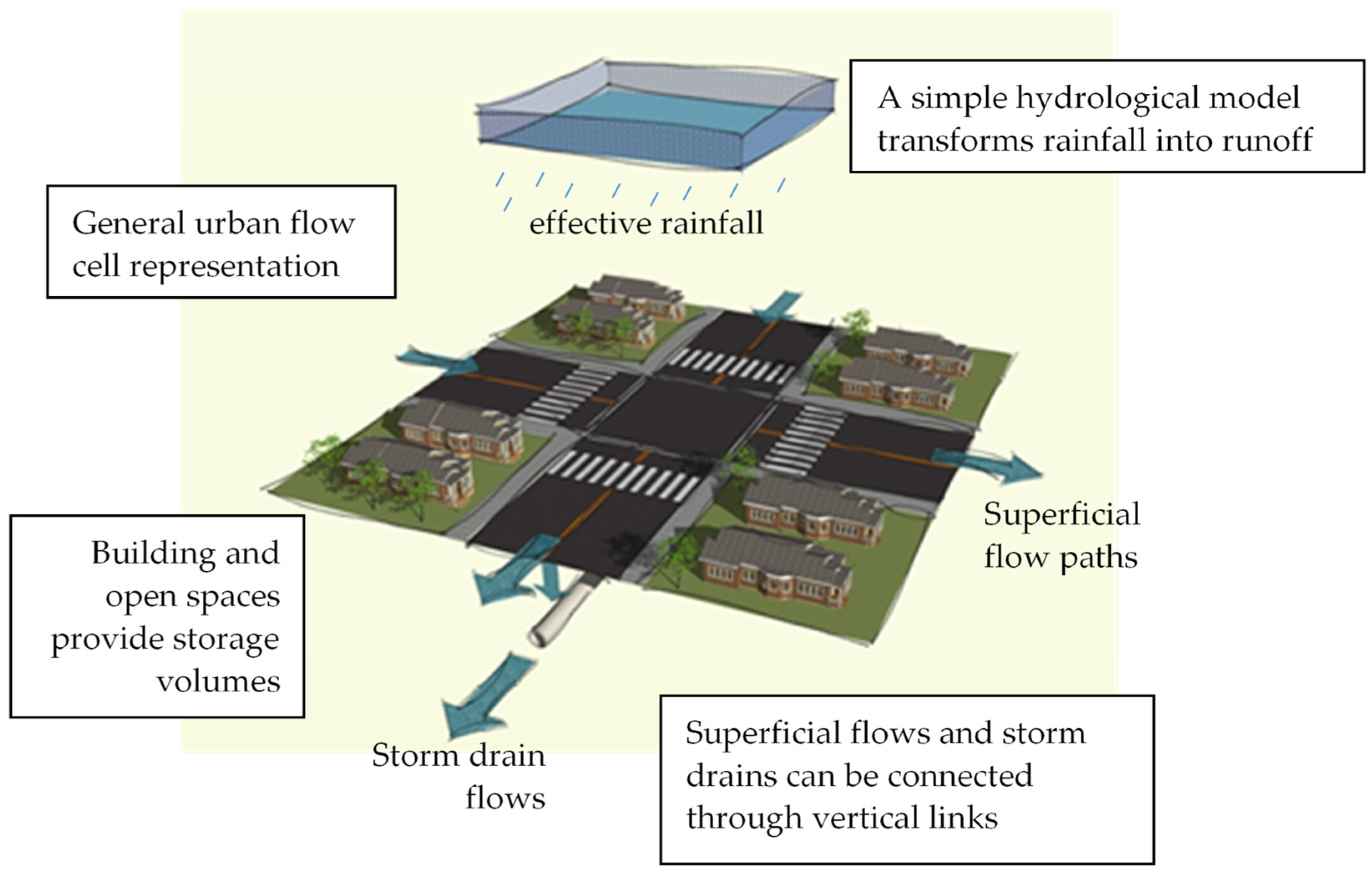
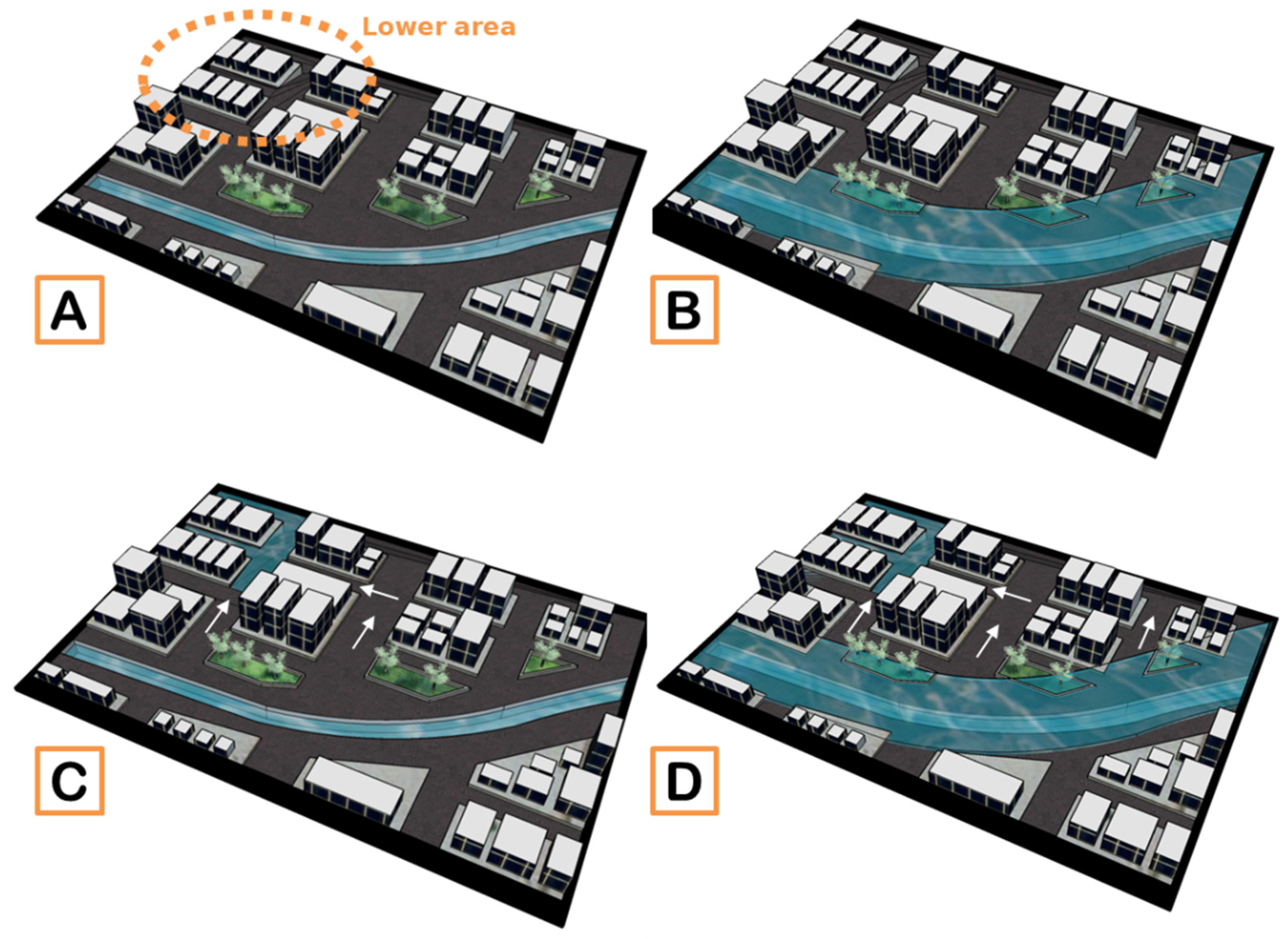
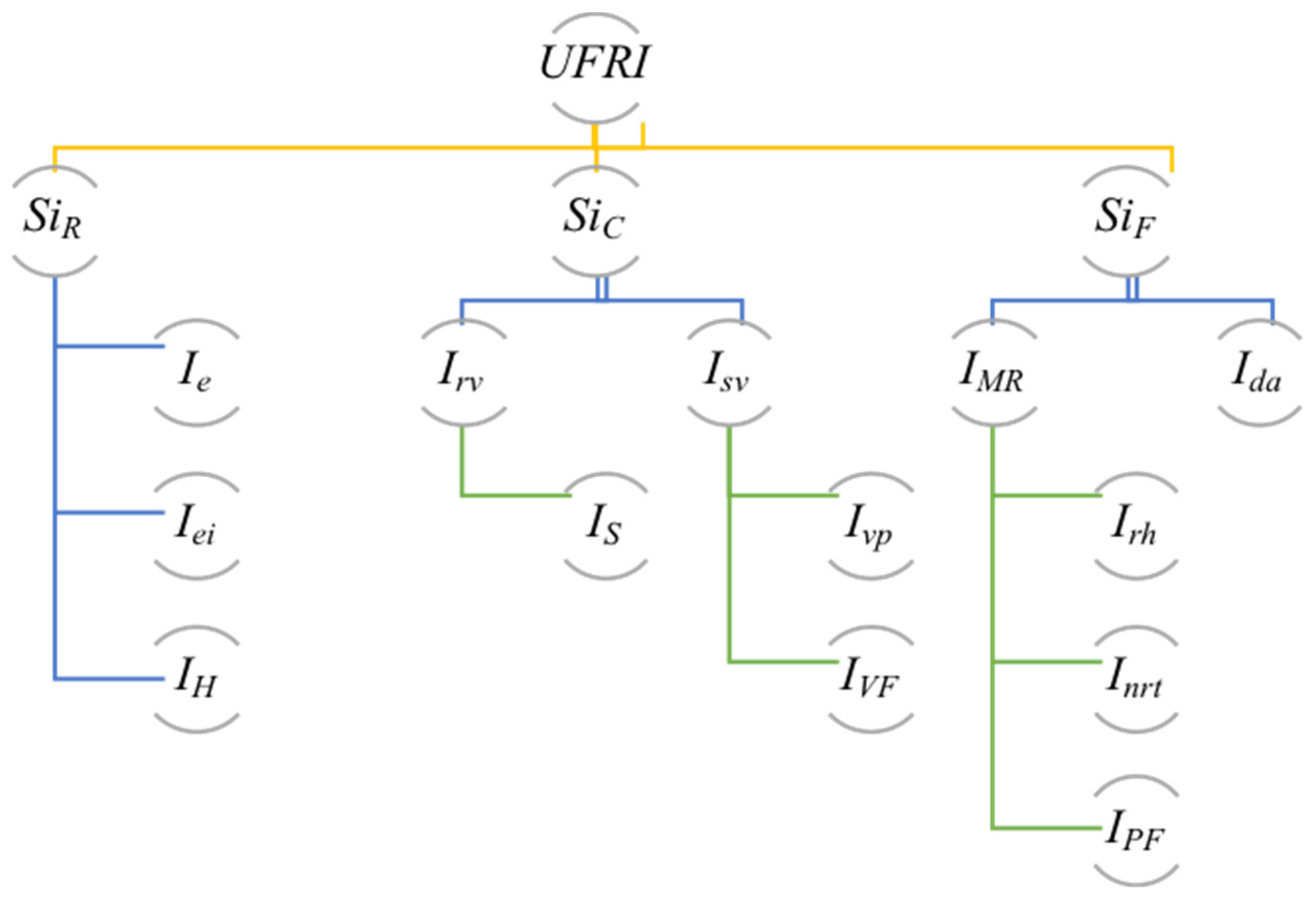

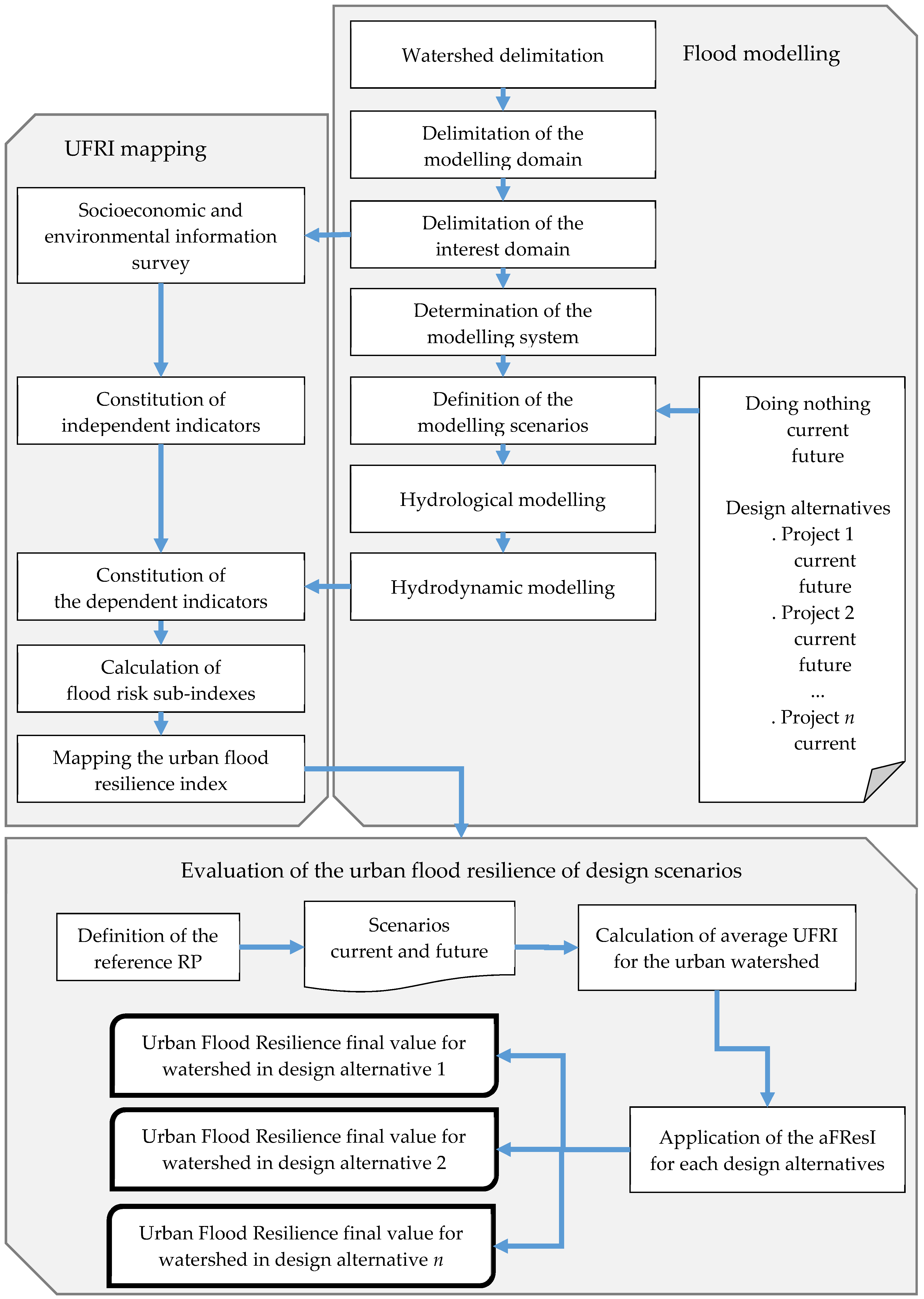
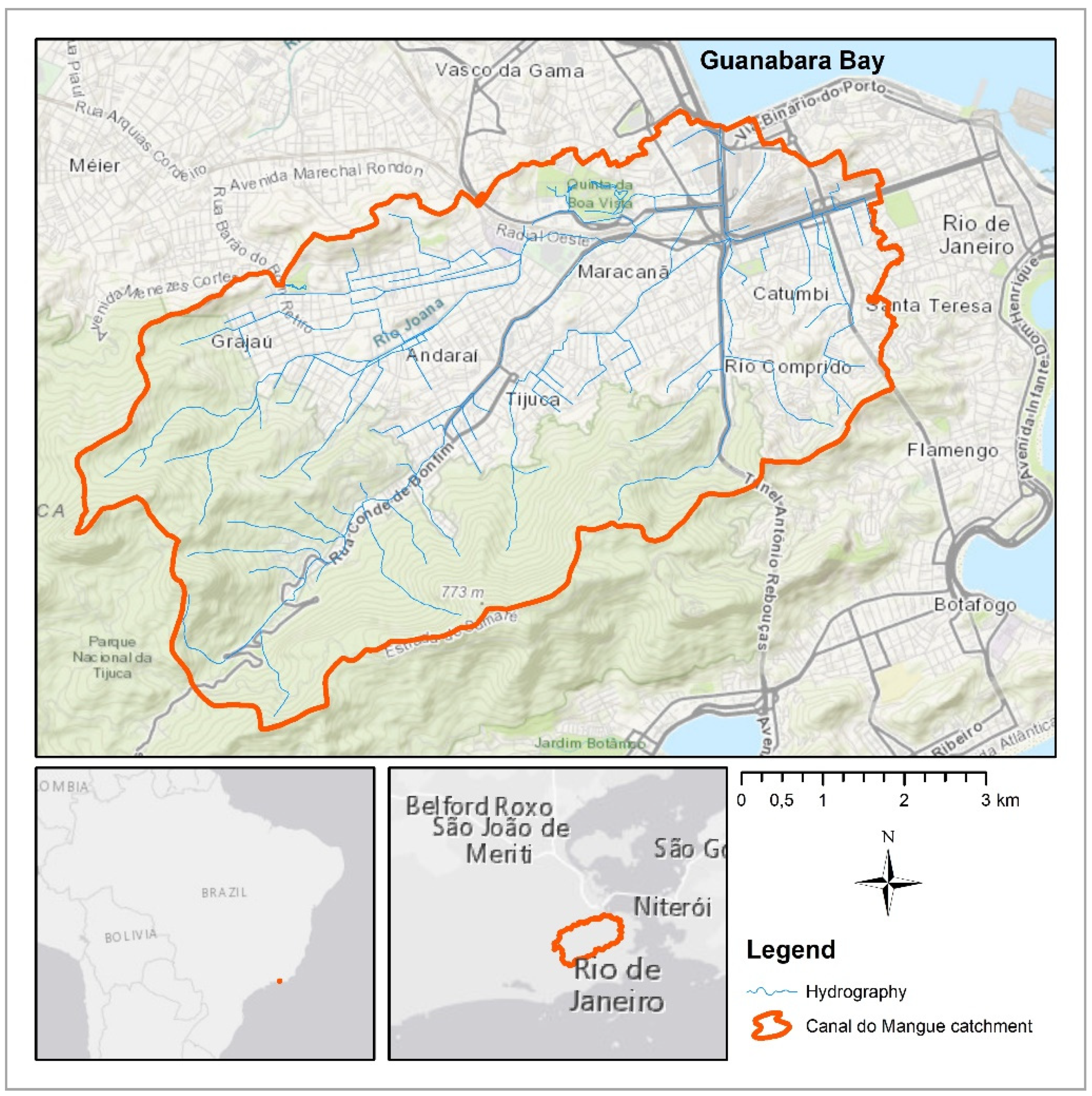
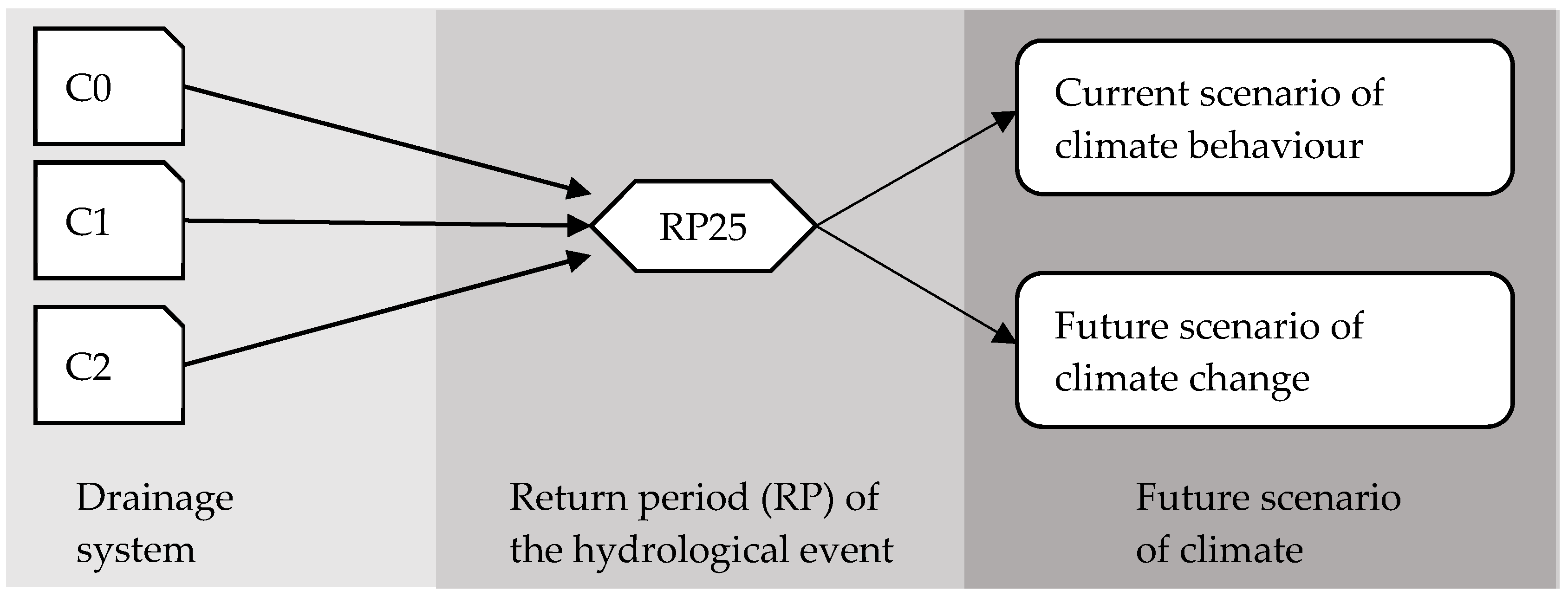

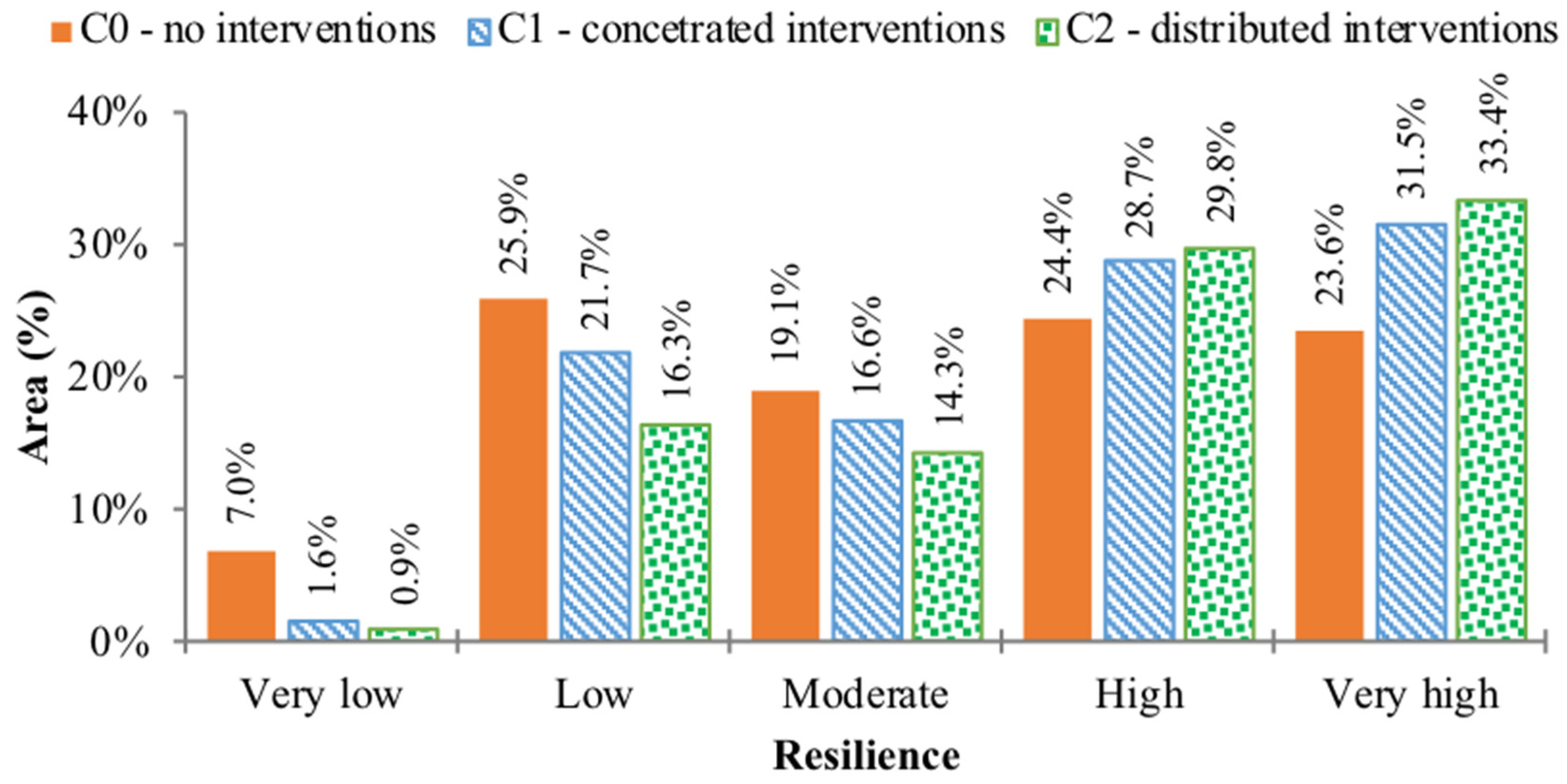

| Vulnerable People—V | Non-Vulnerable People—NV | ||||
|---|---|---|---|---|---|
| Risk | VF | Risk | VF | ||
| Null | 0.050 | 0.00 | Null | 0.000 | 0.00 |
| Low | 0.100 | 0.09 | Low | 0.300 | 0.09 |
| Moderate | 0.175 | 0.63 | Moderate | 0.500 | 0.63 |
| High | 0.250 | 1.00 | High | 0.700 | 1.00 |
| Hierarchy | |
|---|---|
| 1 | 1.00 |
| 2 | 0.94 |
| 3 | 0.77 |
| 4 | 0.50 |
| 5 | 0.11 |
| Class | Number of Rail Stations in a Radius of | Total Number of | Irt | |
|---|---|---|---|---|
| 500 m | 1000 m | Rail Stations | ||
| 1 | 0 | 0 | 0 | 0.00 |
| 2 | 0 | 1 | 1 | 0.21 |
| 3 | 1 | 0 | 1 | 0.34 |
| 4 | 0 | 2 | 2 | 0.44 |
| 5 | 1 | 1 | 2 | 0.51 |
| 6 | 2 | 0 | 2 | 0.57 |
| 7 | 0 | 3 | 3 | 0.62 |
| 8 | 1 | 2 | 3 | 0.66 |
| 9 | 2 | 1 | 3 | 0.70 |
| 10 | 3 | 0 | 3 | 0.74 |
| 11 | 0 | 4 | 4 | 0.77 |
| 12 | 1 | 3 | 4 | 0.80 |
| 13 | 2 | 2 | 4 | 0.82 |
| 14 | 3 | 1 | 4 | 0.85 |
| 15 | 0 | 5 | 5 | 0.87 |
| 16 | 1 | 4 | 5 | 0.89 |
| 17 | 2 | 3 | 5 | 0.91 |
| 18 | 3 | 2 | 5 | 0.93 |
| 19 | 0 | 6 | 6 | 0.95 |
| 20 | 1 | 5 | 6 | 0.96 |
| 21 | 2 | 4 | 6 | 0.98 |
| 22 | 3 | 3 | 6 | 1.00 |
| Resilience | UFRI Values |
|---|---|
| Very low | 0.00–0.25 |
| Low | 0.25–0.49 |
| Moderate | 0.50–0.69 |
| High | 0.70–0.89 |
| Very high | 0.90–1.00 |
| Alternatives | UFRI | |
|---|---|---|
| Current | Future | |
| C0—doing nothing | 0.65 | 0.60 |
| C1—concentrated interventions | 0.73 | 0.68 |
| C2—distributed interventions | 0.78 | 0.73 |
© 2019 by the authors. Licensee MDPI, Basel, Switzerland. This article is an open access article distributed under the terms and conditions of the Creative Commons Attribution (CC BY) license (http://creativecommons.org/licenses/by/4.0/).
Share and Cite
Rezende, O.M.; Miranda, F.M.; Haddad, A.N.; Miguez, M.G. A Framework to Evaluate Urban Flood Resilience of Design Alternatives for Flood Defence Considering Future Adverse Scenarios. Water 2019, 11, 1485. https://doi.org/10.3390/w11071485
Rezende OM, Miranda FM, Haddad AN, Miguez MG. A Framework to Evaluate Urban Flood Resilience of Design Alternatives for Flood Defence Considering Future Adverse Scenarios. Water. 2019; 11(7):1485. https://doi.org/10.3390/w11071485
Chicago/Turabian StyleRezende, Osvaldo M., Francis M. Miranda, Assed N. Haddad, and Marcelo G. Miguez. 2019. "A Framework to Evaluate Urban Flood Resilience of Design Alternatives for Flood Defence Considering Future Adverse Scenarios" Water 11, no. 7: 1485. https://doi.org/10.3390/w11071485
APA StyleRezende, O. M., Miranda, F. M., Haddad, A. N., & Miguez, M. G. (2019). A Framework to Evaluate Urban Flood Resilience of Design Alternatives for Flood Defence Considering Future Adverse Scenarios. Water, 11(7), 1485. https://doi.org/10.3390/w11071485








